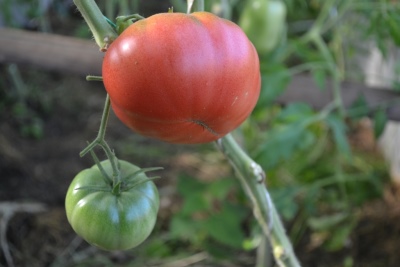
- Category: grade
- Growth type: indeterminate
- Appointment: universal
- Ripening period: mid-season
- Ripening time, days: 100-105
- Growing conditions: for open ground, for film greenhouses
- Transportability: good
- Bush size: medium-sized
- Bush height, cm: up to 100
- Leaves: potato type
Many gourmets who prefer medium-sized sugary tomatoes will certainly be interested in the interestingly named Potato Raspberry variety. However, the variety is capricious, difficult to care for, so it is not suitable for everyone - it is quite difficult to grow a crop of such fruits, for this you will have to make an effort. But efforts will be rewarded, because the fruits are quite impressive in weight - up to 0.8 kg, and also have a wonderful taste.
Breeding history
Raspberry potato is a variety that was bred in Russia in 1999 and almost immediately, the next year, entered into the State Register of the Russian Federation as a crop that can be cultivated in open or closed ground.
Description of the variety
The variety is an indeterminate crop. However, it differs in average height and grows up to one meter or slightly higher. This is a standard type of plant. The characteristic appearance of the leaves, similar to the tops of potatoes, gave the name to the culture. The fruits themselves are formed in a brush from 3 to 6 pieces.
The main qualities of the fruit
Raspberry potato is a rather large tomato. At the same time, the lower branches delight with 800-gram specimens, while on the higher branches, fruits weighing 600 or 700 grams ripen, which is also a lot. Tomatoes have a flat-round shape, their ribbing is weak, the color of ripe fruits is bright crimson or red. Each fruit has 6 or 7 chambers in which the seeds are located.
Taste characteristics
The pulp is quite juicy, its taste is sugary. Therefore, it is better to use the fruits immediately after harvesting in order to fully experience all the flavor characteristics of the variety. Interestingly, potato raspberry tomatoes can be included in the menu even for allergy sufferers. In addition to eating fresh, tomatoes are still used for preparations - pastes, juice or other dishes, with the exception of whole-fruit canning.
Ripening and fruiting
A mid-season fruiting variety, after planting the seeds, 100-105 days should pass before the berries ripen. This culture differs in that the tomatoes ripen together, that is, the harvest can be done quite quickly. But if it so happened that before the cold weather they still did not have time to collect individual fruits, you can remove them in an immature form - they may well ripen on the windowsill. Unfortunately, such tomatoes cannot be stored for a long time.
Yield
The culture is distinguished by expectedly large yields. From one plant harvested from 4 to 6 kilograms.
The timing of planting seedlings and planting in the ground
In March or April, you can plant seeds for seedlings, and after 50-60 days, the grown material is planted in the place of further cultivation.

Growing tomato seedlings is an extremely important process, because it largely depends on whether the gardener can harvest at all. All aspects must be taken into account, from seedbed preparation to planting in the ground.
Landing scheme
One square meter has the ability to place from 3 to 5 trunks. The gardener himself chooses his layout.

Growing and caring
To grow an indeterminate standard bush, you should install strong supports next to each of them, so that you can then tie up the branches. So they will not break from heavy fruits and the force of the wind. And it is also necessary to pinch the variety in order to leave a couple of stems for further growth, one of which will be the main one, and the other - lateral.
Potato raspberry is a very thermophilic and also light-loving plant. In regions with a small amount of light and heat, it is grown, covering, illuminating in greenhouses.
Watering is equally important. Schedule - 2 times in 7 days. But it is important not to flood the culture, otherwise it will lead to various diseases or decay of the roots. At the same time, if the soil is slightly moistened, the calcium from the tomatoes will move to the green mass, the bush will grow, and there will be no harvest.
Particular attention should be paid to thinning the plants to increase light transmission to the fruit.




A plant needs different micronutrients at each stage of growth. All fertilizers can be divided into two groups: mineral and organic. Folk remedies are often used: iodine, yeast, bird droppings, eggshells.
It is important to observe the rate and period of feeding. This also applies to folk remedies and organic fertilizers.


Growing regions
Potato raspberry feels very good in the south, in other regions with a warm climate, in an area bathed in the sun. In central Russia, in cooler areas, shelters are needed.
The most favorable regions for cultivating the variety will be:
- Crimea;
- Donetsk;
- Astrakhan;
- Belgorod;
- Volgograd;
- Kuban.

























































































